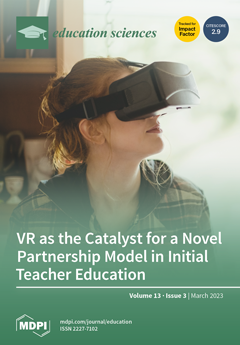The integration of STEM—Science, Technology, Engineering, and Mathematics—education in the curricula has become a priority in contemporary education, where teachers have a decisive role. Thus, research has focused on teachers’ readiness for STEM education, where the prerequisite is to ensure valid measurements. In
[...] Read more.
The integration of STEM—Science, Technology, Engineering, and Mathematics—education in the curricula has become a priority in contemporary education, where teachers have a decisive role. Thus, research has focused on teachers’ readiness for STEM education, where the prerequisite is to ensure valid measurements. In this study, we present the psychometric properties of the TRi-STEM scale, validated to measure teachers’ readiness in implementing STEM education. The proposed scale was based on questionnaires that appeared in the literature, and the final form was adopted and refined for Greek in-service teachers (
N = 494), via exploratory and confirmatory factor analyses. TRi-STEM comprises four dimensions: affective conditions (AC), cognitive conditions (CC), self-efficacy (SE), and STEM commitment (SC). The reliability measures of the four factors were AC (
α = 0.972/
ω = 0.972), CC (
α = 0.976/
ω = 0.976), SE (
α = 0.934/
ω = 0.935), and SC (
α = 0.886/
ω = 0.885), and confirmatory factor analysis showed a satisfactory fit [
χ2(249) = 981.287,
p < 0.001,
TLI = 0.942,
CFI = 0.948,
GFI = 0.993,
NNFI = 0.942,
RMSEA = 0.078 (0.073–0.083), and
SRMR = 0.062]. In addition, measurement invariance was carried out for gender, age, years of service, school level, and university degrees. The TRi-STEM scale is an essential and applicable tool to ensure validity in educational research and support further hypotheses testing.
Full article





